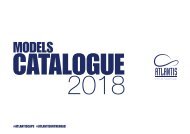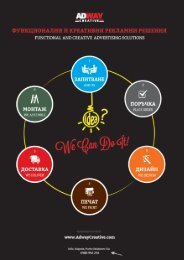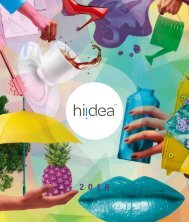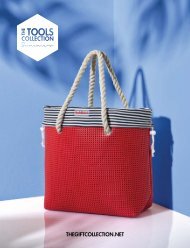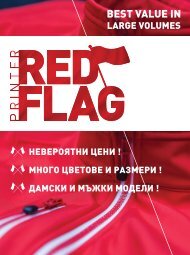- Page 2 and 3:
EUROPEAN CERTIFICATION? YES, WE HAV
- Page 4 and 5:
Promotional products must comply wi
- Page 6 and 7:
Facts & Figures A multi-coloured pe
- Page 8 and 9:
Page 27 3781 3020 3444 Page 27 Page
- Page 10 and 11:
6638 Plastic ballpen with coloured
- Page 12 and 13:
04 05 06 07 17 5210 Plastic ballpen
- Page 14 and 15:
MADE BY IMPRESSION 24 4963 Coloured
- Page 16 and 17:
18 02 08 05 01 5358 Plastic twist a
- Page 18 and 19:
08 07 2437 Platic swan shaped ballp
- Page 20 and 21:
02 03 05 06 07 08 01 10 17 18 24 32
- Page 22 and 23:
Colour it! 24 01 04 06 05 18 For th
- Page 24 and 25:
01 02 04 05 07 08 24 169 187 188 19
- Page 26 and 27:
01 07 08 18 23 24 01 02 05 07 08 40
- Page 28 and 29:
01 02 05 08 32 5466 Aluminium ballp
- Page 30 and 31:
32 551 5470 Plastic twist ballpen,
- Page 32 and 33:
30 Writing Instruments
- Page 34 and 35:
50 84 50 2055 Lacquered metal ballp
- Page 36 and 37:
40 01 02 05 32 3876 Metal push butt
- Page 38 and 39:
4580 Metal ballpen with silver trim
- Page 40 and 41:
ECO IS TRENDY 5741 Maplewood pen se
- Page 42 and 43:
11 11 3788 Wooden twist action ball
- Page 44 and 45:
11 11 8120 Rosewood ballpen with bl
- Page 46 and 47:
01 05 08 13 24 01 05 07 08 19 32 64
- Page 48 and 49:
SCAN&PLAY 01 05 08 17 5445 Plastic
- Page 50 and 51:
01 02 01 02 06 07 08 23 29 32 5459
- Page 52 and 53:
04 08 01 05 24 01 05 08 32 3857 Sty
- Page 54 and 55:
01 05 32 08 5307 Plastic ballpen in
- Page 56 and 57:
08 08 01 05 24 07 17 18 29 3306 Pla
- Page 58 and 59:
09 2460 Wooden witch pencil (twenty
- Page 60 and 61:
09 09 1208 Unsharpened pencil with
- Page 62 and 63:
05 06 07 35cm 08 17 18 01 02 40 45
- Page 64 and 65:
SCAN&PLAY 02 02 3445 Set of three g
- Page 66 and 67:
04 05 08 5495 Plastic ballpen in sh
- Page 68 and 69:
01 02 07 08 12 17 23 219 2100 Parke
- Page 70 and 71:
The pen is mightier than the sword
- Page 72 and 73:
5431 Rotring brass ballpen with pus
- Page 74 and 75:
Facts & Figures TRENDS TO WORK WITH
- Page 76 and 77:
EUROPEAN CERTIFICATION? YES, WE HAV
- Page 78 and 79:
01 01 1083 Charles Dickens® metal
- Page 80 and 81:
SCAN&PLAY 50 01 01 3877 Charles Dic
- Page 82 and 83:
4119 Charles Dickens® polyester au
- Page 84 and 85:
+ 01 -- A5 + -- A6 01 0976 Charles
- Page 86 and 87:
6457 Leather Charles Dickens® wall
- Page 88 and 89:
Facts & Figures Everything eco-frie
- Page 90 and 91:
21 02 5242 PVC magnifying glass in
- Page 92 and 93:
EUROPEAN CERTIFICATION? YES, WE HAV
- Page 94 and 95:
32 50 2917 ABS Ruler (20cm) with a
- Page 96 and 97:
SCAN&PLAY 32 32 4488 Plastic eight
- Page 98 and 99:
01 04 07 08 18 24 2019 Ballpen with
- Page 100 and 101:
01 + -- A6 08 06 07 07 08 + -- A5 1
- Page 102 and 103:
07 29 01 90 18 2715 Spiral bound no
- Page 104 and 105:
01 01 32 8005 Plastic case holding
- Page 106 and 107:
01 02 07 08 23 03 24 29 08 18 19 23
- Page 108 and 109:
106 Office & Business
- Page 110 and 111:
01 07 08 17 19 + -- A6 23 24 0948 S
- Page 112 and 113:
110 Office & Business A size for ev
- Page 114 and 115:
02 01 32 08 18 8358 Plastic bank ca
- Page 116 and 117:
01 01 8701 Deluxe bonded leather bu
- Page 118 and 119:
2716 Nylon (300D) note book with ap
- Page 120 and 121:
01 05 + -- A4 + -- A5 05 01 8620 A4
- Page 122 and 123:
120 Office & Business Mini me
- Page 124 and 125:
122 Office & Business
- Page 126 and 127:
+ -- A4 + -- A4 01 01 8523 Bonded l
- Page 128 and 129:
Map something out 126 Office & Busi
- Page 130 and 131:
11 11 + -- A4 + -- A5 4297 A4 cork
- Page 132 and 133:
+ -- A4 01 + -- A4 01 8410 A4 zippe
- Page 134 and 135:
132 Office & Business
- Page 136 and 137:
03 6692 Svepa PU zippered travel wa
- Page 138 and 139:
COLOURED OFFICE 01 PAGE 109 2889 02
- Page 140 and 141:
01 02 04 05 08 01 02 08 23 32 5851
- Page 142 and 143:
01 05 08 5350 Acrylic pair of glove
- Page 144 and 145:
02 SCAN&PLAY 01 02 23 08 18 1834 Pa
- Page 146 and 147:
5436 ABS blue tooth speaker, includ
- Page 148 and 149:
5368 Aluminium solar charger, with
- Page 150 and 151:
06 08 01 02 07 23 3280 Plastic car
- Page 152 and 153:
01 02 08 5291 USB, silicon bookligh
- Page 154 and 155:
SCAN&PLAY 02 1829 Bluetooth selfie
- Page 156 and 157:
5732 Metal laser pointer with a bla
- Page 158 and 159:
07 29 08 23 27 3073 ABS flexi man a
- Page 160 and 161:
4769 Plastic weather station with w
- Page 162 and 163:
01 32 4787 Plastic digital weather
- Page 164 and 165:
32 02 6515 Plastic digital weather
- Page 166 and 167:
4763 Plastic weather station, featu
- Page 168 and 169:
have a lot of rain, a poncho Facts
- Page 170 and 171:
02 06 07 08 29 02 07 18 9139 PE Pon
- Page 172 and 173:
04 05 07 08 10 13 5247 Foldable aut
- Page 174 and 175:
01 02 04 05 06 08 09 07 13 17 18 23
- Page 176 and 177:
05 01 05 01 2796 Manual polyester (
- Page 178 and 179:
4005 Manual polyester (170T) childr
- Page 180 and 181:
6487 Transparent POE automatic umbr
- Page 182 and 183:
4016 Manual polyester (190T) umbrel
- Page 184 and 185:
52 01 03 54 05 06 50 29 84 07 08 18
- Page 186 and 187:
08 01 02 04 05 10 4066 Manual polye
- Page 188 and 189:
02 04 06 08 01 03 05 07 09 10 17 40
- Page 190 and 191:
01 03 08 05 07 1741 Polyester fleec
- Page 192 and 193:
Facts & Figures it’s a fact All p
- Page 194 and 195:
23 SCAN&PLAY EUROPEAN CERTIFICATION
- Page 196 and 197:
Bon appétit! SCAN&PLAY 05 02 3459
- Page 198 and 199:
07 17 23 29 SCAN&PLAY 02 2287 Snack
- Page 200 and 201:
ANTI- SLIP 01 05 08 19 05 08 13 664
- Page 202 and 203:
High temperature! 01 2634 Stainless
- Page 204 and 205:
Salt & Pepper 3724 Stainless steel
- Page 206 and 207:
32 11 9033 Set of three stainless s
- Page 208 and 209:
SPECIAL MOMENTS DINNER IS BETTER WH
- Page 210 and 211:
4657 Wooden cheeseboard with magnet
- Page 212 and 213:
02 6584 Plastic bottle opener in sh
- Page 214 and 215:
21 3739 Frosted plastic bottle cool
- Page 216 and 217:
01 6732 Plastic vacuum wine stopper
- Page 218 and 219:
00 6821 Four piece wine set present
- Page 220 and 221:
01 02 3070 3pcs plastic cocktail sh
- Page 222 and 223:
02 01 2848 Ceramic mug (170ml)(sold
- Page 224 and 225:
03 05 18 06 07 08 08 29 112 130 112
- Page 226 and 227:
02 3177 Porcelain cup and saucer (8
- Page 228 and 229:
SCAN&PLAY Warm it up on your cup ST
- Page 230 and 231:
32 2743 Plastic photo frame with an
- Page 232 and 233:
High quality tea Straight from the
- Page 234 and 235:
09 6763 Luxurious tea glass set con
- Page 236 and 237:
CUSTOM MADE Also available in custo
- Page 238 and 239:
Facts & Figures TRENDS TO WORK WITH
- Page 240 and 241:
45 1134 EVA foam sail ship shaped,
- Page 242 and 243:
2131 1.5m Plastic household tape me
- Page 244 and 245:
2540 Plastic key holder with compas
- Page 246 and 247:
5157 Round, plastic key holder, pap
- Page 248 and 249:
8671 Player metal key holder, suppl
- Page 250 and 251:
32 32 8679 Round metal key holder,
- Page 252 and 253:
02 07 3133 Plastic ID pass holder w
- Page 254 and 255:
23 01 01 04 06 08 10 05 9124 Nylon
- Page 256 and 257:
01 01 2778 Bonded leather wallet wi
- Page 258 and 259:
18 01 02 08 18 01 02 08 6495 Large,
- Page 260 and 261:
08 02 21 23 29 02 08 21 23 29 5251
- Page 262 and 263:
06 08 02 23 02 23 6679 Truck shaped
- Page 264 and 265:
In good hands 1110 Hand spray in a
- Page 266 and 267:
08 32 33 7624 Four piece manicure s
- Page 268 and 269:
01 02 06 05 17 18 07 08 24 29 32 95
- Page 270 and 271:
08 - 28 S - M 08 - 36 L - XL 13 - 2
- Page 272 and 273:
let’s take care 01 PAGE 439 1342
- Page 274 and 275:
SCAN&PLAY 21 08 6559 Plastic, 1.5 m
- Page 276 and 277:
8078 Anti stress football made from
- Page 278 and 279:
3690 PU foam anti stress decision m
- Page 280 and 281:
Facts & Figures TRENDS TO WORK WITH
- Page 282 and 283:
6266 Foldable polyester carrying/sh
- Page 284 and 285:
02 05 08 5666 Nonwoven postman shou
- Page 286 and 287:
01 02 04 05 06 07 08 23 2314 Colour
- Page 288 and 289:
01 02 04 06 07 05 08 13 23 24 6227
- Page 290 and 291:
Healthy shopping day 03 03 7512 Oxf
- Page 292 and 293:
02 06 08 23 3609 Polyester (420D) c
- Page 294 and 295:
02 06 08 23 3637 Polyester (600D) c
- Page 296 and 297:
01 23 02 6545 Mini fridge with spac
- Page 298 and 299:
311 4223 Jute bag with plastic back
- Page 300 and 301:
07 01 02 05 07 02 01 08 17 08 23 62
- Page 302 and 303:
01 07 05 19 08 19 23 08 3519 Polyes
- Page 304 and 305:
01 03 05 08 13 5622 Ripstop explore
- Page 306 and 307:
01 05 9100 A4 Nylon document bag (7
- Page 308 and 309:
08 01 03 05 07 19 23 4343 Polyester
- Page 310 and 311:
11 01 05 05 3900 PU postman bag wit
- Page 312 and 313:
199 199 3432 Canvas duffel bag (16o
- Page 314 and 315:
42 6364 Polyester (300D) laptop bag
- Page 316 and 317:
05 05 5576 Polyester sports/travel
- Page 318 and 319:
01 01 02 02 3572 Polyester (600D) s
- Page 320 and 321:
05 01 01 08 08 18 19 5675 Polyester
- Page 322 and 323:
SCAN&PLAY 04 01 08 3562 Polyester (
- Page 324 and 325:
02 02 7475 Polyester (600D) round s
- Page 326 and 327:
01 SCAN&PLAY 01 6119 Microfiber lap
- Page 328 and 329:
01 01 0925 Polyester (1680D) travel
- Page 330 and 331:
32 03 6978 PC/ABS matt silver troll
- Page 332 and 333:
SCAN&PLAY 01 6443 ABS digital lugga
- Page 334 and 335:
Take the suit roller in a suitcase
- Page 336 and 337:
6260 Non-woven (80g/m 2 ), zippered
- Page 338 and 339:
08 17 18 01 07 21 6447 PVC Frosted
- Page 340 and 341:
07 18 08 29 05 08 18 27 4006 Polyes
- Page 342 and 343:
Facts & Figures Host your own garde
- Page 344 and 345:
EUROPEAN CERTIFICATION? YES, WE HAV
- Page 346 and 347:
SCAN&PLAY 06 29 07 4292 Tritan wate
- Page 348 and 349:
23 02 08 29 32 6535 Stainless steel
- Page 350 and 351:
SCAN&PLAY 01 2284 Plastic protein s
- Page 352 and 353:
SCAN&PLAY 01 02 18 07 08 19 01 23 6
- Page 354 and 355:
06 18 20 6715 Stainless steel, doub
- Page 356 and 357:
00 4678 Stainless steel double wall
- Page 358 and 359:
11 11 5794 Willow picnic basket for
- Page 360 and 361:
09 29 6462 3pcs Garden tools for ch
- Page 362 and 363:
32 6490 Stainless steel, solar boll
- Page 364 and 365:
2637 Three piece stainless steel ba
- Page 366 and 367:
Play time 09 09 2701 Plastic beach
- Page 368 and 369:
04 05 06 07 08 24 40 26cm 9620 PVC
- Page 370 and 371:
2582 Bat and ball set with chess an
- Page 372 and 373:
SCAN&PLAY 05 3195 Plastic UV watch.
- Page 374 and 375:
02 06 08 17 29 18 6510 Fabric hand
- Page 376 and 377:
06 01 01 05 07 08 UV400 06 1152 Vin
- Page 378 and 379:
UV400 01 Typical eyecatcher UV400 0
- Page 380 and 381:
08 08 01 02 04 01 02 06 05 06 07 18
- Page 382 and 383:
01 2544 Key holder with a plastic c
- Page 384 and 385:
3786 Aluminium and rubber binocular
- Page 386 and 387:
Facts & Figures TRENDS TO WORK WITH
- Page 388 and 389:
EUROPEAN CERTIFICATION YES, WE HAVE
- Page 390 and 391:
01 05 1987 Plastic key holder with
- Page 392 and 393:
3296 ABS pocket light with one LED,
- Page 394 and 395:
01 06 07 08 23 29 32 4867 Metal bot
- Page 396 and 397:
01 02 23 04 2245 ABS camping light
- Page 398 and 399:
08 23 32 32 4851 Aluminium push but
- Page 400 and 401:
01 4837 Steel pocket torch with fou
- Page 402 and 403:
3635 Steel multi tool with aluminiu
- Page 404 and 405:
02 05 01 19 08 32 SCAN&PLAY 0964 Pl
- Page 406 and 407:
SCAN&PLAY 01 32 4807 ABS head light
- Page 408 and 409:
32 5M 6526 5m Metric only tape meas
- Page 410 and 411:
3M 2M 32 01 6523 3m Metric/imperial
- Page 412 and 413:
01 05 50 08 27 4081 3pc Metal/plast
- Page 414 and 415:
23 03 4853 Steel pen shaped screwdr
- Page 416 and 417:
50 27 7465 Twenty five piece toolse
- Page 418 and 419:
RIDING IN STYLE PAGE 186 4068 2140
- Page 420 and 421:
06 18 06 5300 Three piece carwash s
- Page 422 and 423:
SCAN&PLAY 01 2573 Polyester (600D)
- Page 424 and 425: AS snow IN THE SUN 02 06 07 02 05 M
- Page 426 and 427: SCAN&PLAY 01 01 3769 Car battery ch
- Page 428 and 429: 8124 Safety reflector (both sides)
- Page 430 and 431: 02 01 08 6981 Bicycle bag with mesh
- Page 432 and 433: FREE running 01 PAGE 433 5367 02 PA
- Page 434 and 435: SCAN&PLAY 07 06 32 08 6024 Reflecti
- Page 436 and 437: 01 4126 Neoprene mobile phone holde
- Page 438 and 439: M 06 07 XL S 06 XXL 6542 100% Polye
- Page 440 and 441: 08 08 6556 Plastic first aid kit, c
- Page 442 and 443: 08 6544 40 piece car emergency firs
- Page 444 and 445: 2 Facts & Figures Follow the trend!
- Page 446 and 447: 2545 School set with pencils, erase
- Page 448 and 449: 06 08 18 11 2785 Six hexagonal colo
- Page 450 and 451: 00 00 2788 Six small crayons in a r
- Page 452 and 453: 09 2794 68pc artist set in a plasti
- Page 454 and 455: COLOURING KLEURBOEK LIVRE À COLORI
- Page 456 and 457: 1906 Plaster piggy bank, includes o
- Page 458 and 459: 06 11 29 40 6474 Plush cloth, 19 x
- Page 460 and 461: 09 09 2751 Cotton stuffed, girl sha
- Page 462 and 463: 29 3539 Plastic bubble gun with con
- Page 464 and 465: 9078 Cotton sweatband with a white
- Page 466 and 467: SCAN&PLAY SCAN&PLAY 04 08 23 32 31
- Page 468 and 469: 3783 Transparent plastic light-up y
- Page 470 and 471: 09 01 2553 Games set in a wooden bo
- Page 472 and 473: A 00 01 02 03 04 05 06 07 08 09 10






